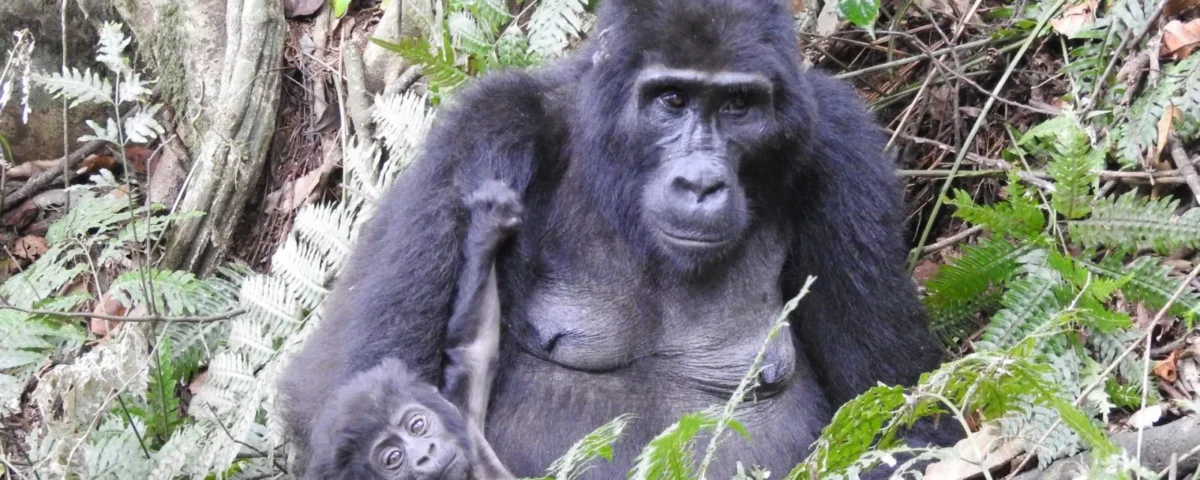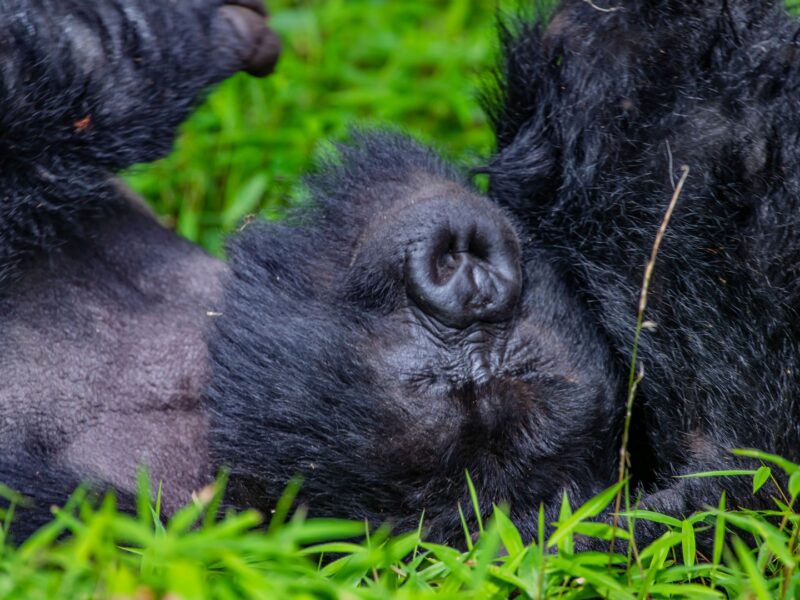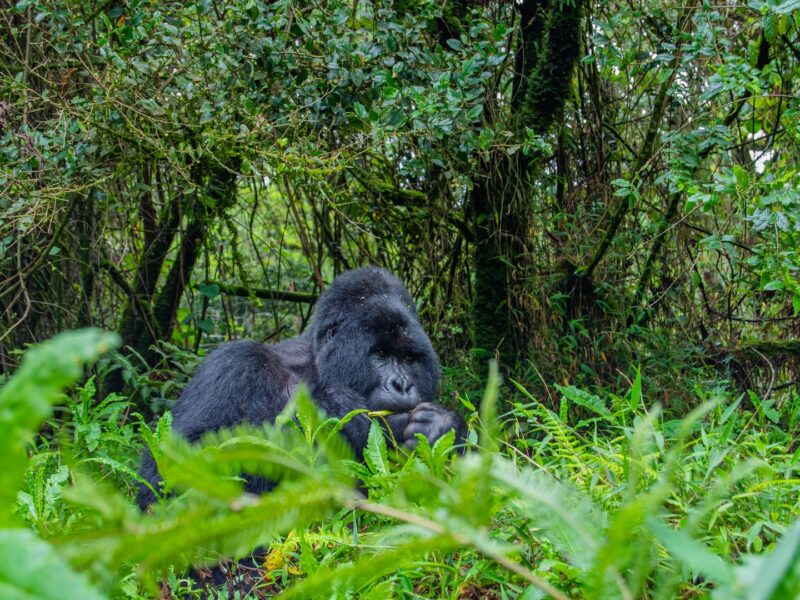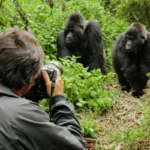
What to Pack for Gorilla Trekking
July 17, 2025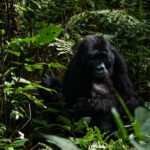
Is It Possible to Do Research on Gorillas in Uganda?
July 17, 2025Travel Tips for a Smooth Uganda Gorilla Safari: From Arrival to the Forest
By Ngeye Tours & Travel
How do you plan the best gorilla trekking safari from arrival to Bwindi Impenetrable National Park?
For many, planning a Uganda gorilla safari starts months in advance but what should you know once you touch down in Uganda? After arrival in Entebbe, most travelers overnight in Kampala or Entebbe before starting the overland journey or domestic flight to Bwindi Impenetrable National Park. Overland routes take about 8–10 hours, winding past terraced hills, tea plantations, and crater lakes—making the journey itself part of the safari story.
Travelers ask: “What makes the best gorilla trekking safari from Entebbe to Bwindi?” The answer is thoughtful pacing. At Ngeye Tours & Travel, we recommend a balanced itinerary: start with a night to rest after your flight, then continue to Bwindi via scenic stops like Lake Mburo National Park—perfect for spotting zebra and impala. For those who prefer to skip long drives, domestic flights to Kihihi or Kisoro airstrips dramatically reduce travel time, leaving you more energy for the trek.
Whichever route you choose, traveling with an experienced local operator simplifies logistics: arranging gorilla trekking permits, transfers, and accommodations near the right trailhead (Buhoma, Ruhija, Rushaga, or Nkuringo). Each sector has its character: Buhoma offers historic lodges and gentler hikes, while Rushaga and Nkuringo reward adventurous trekkers with dramatic landscapes.
What should travelers know before stepping into Bwindi Impenetrable forest for gorilla trekking?
Stepping into the Bwindi Impenetrable forest feels like entering another world: ancient trees tangled with moss, shafts of light breaking through the canopy, and a silence punctuated by bird calls and distant rustles. But how should travelers prepare for this experience?
First, know your permit. Gorilla trekking permits are limited (currently USD 800 per person for foreign non-residents) and should be booked months ahead, especially for peak seasons (June–September, December–February). Dressing right matters too: wear sturdy waterproof hiking boots, long trousers, and gaiters to protect against mud and stinging nettles. A lightweight rain jacket and quick-dry layers help with the forest’s sudden showers.
Travelers often ask, “How fit do I need to be for gorilla trekking safaris?” While treks range from gentle two-hour walks to challenging hikes over steep ridges, a reasonable level of fitness and flexibility helps you enjoy the journey rather than endure it. Porters—often from nearby communities—are invaluable not just for carrying bags, but for steady footing and local insight. Hiring one directly supports conservation-linked livelihoods.
Finally, bring patience and respect. Gorilla trekking isn’t staged: sometimes trackers find the family quickly; other days, it takes hours. But each step through Bwindi Impenetrable National Park adds to the anticipation—making the moment you meet the gorillas even more profound.
How do you choose between regular gorilla trekking and the Gorilla Habituation Experience?
Among questions we hear most at Ngeye Tours & Travel is: “Should I do the regular Uganda gorilla trekking or choose the Gorilla Habituation Experience?” Both take you deep into Bwindi Impenetrable forest, yet differ in time, cost, and focus.
Regular gorilla trekking allows one magical hour with a fully habituated family, costs USD 800, and offers a powerful glimpse of daily life: silverbacks resting under vines, mothers nursing infants, and playful juveniles tumbling nearby. This suits travelers seeking an iconic Africa gorilla trekking moment within a balanced itinerary.
The Gorilla Habituation Experience (USD 1,500) grants up to four hours with a semi-habituated family still learning to accept humans. Guided by researchers, you observe subtle social behaviors and conservation work firsthand. It’s ideal for photographers or wildlife enthusiasts wanting more time and depth.
Whichever you choose, the impact on gorilla protection is real: your permit funds ranger patrols, veterinary care, and community projects. Many travelers even combine both, crafting the best gorilla trekking safari by balancing immersion with flexibility.
What safari activities and cultural tours complement gorilla trekking safaris in Uganda?
One reason Uganda gorilla tours feel so rich is the chance to weave in other safaris and cultural encounters. After meeting gorillas in Bwindi Impenetrable National Park, travelers often ask: “What else can we do to complete our safari?”
Nearby, Queen Elizabeth National Park offers classic game drives with lions, elephants, and Uganda kob. The Kazinga Channel’s boat cruises bring close views of hippos and waterbirds—a photographer’s delight. Further north, Murchison Falls National Park stuns with roaring waterfalls, Nile boat trips, and savanna plains dotted with giraffes and buffaloes.
For primate lovers, Kibale Forest National Park is Africa’s top destination for chimpanzee tracking, with 12 additional primate species. Add cultural depth by visiting the Batwa pygmies near Bwindi: discover forest survival skills, dances, and traditional stories deeply tied to conservation. Travelers can also explore Ankole cattle traditions, historic Buganda kingdoms, or lively craft markets in Kampala.
By combining wildlife, landscapes, and culture, Uganda gorilla safaris transform from a single trek into a layered story of Africa’s richness—making every itinerary as unique as the traveler.
How do you pack smartly for a smooth gorilla trekking adventure?
Packing for gorilla trekking is part science, part art. Beyond standard travel clothes, what ensures comfort in the Bwindi Impenetrable forest?
Start with waterproof hiking boots and long, quick-dry trousers. Add a lightweight, breathable rain jacket—showers can appear without warning. Gaiters protect against mud and nettles, while gardening gloves help grip vines on steep trails. Layering is key: mornings are cool, but forest humidity builds as you hike.
Don’t forget essentials: a wide-brim hat, sunscreen, insect repellent, and a reusable water bottle. A small backpack (often carried by a porter) holds camera gear, snacks, and spare batteries. Respect local culture by dressing modestly around villages.
Finally, bring openness and flexibility. Some treks end by midday; others stretch into afternoon. But every step brings its own discovery—new bird calls, distant waterfalls, or fresh gorilla nests. Packing well ensures you’re free to enjoy the moment, rain or shine.
How do local guides and porters shape the Uganda gorilla trekking experience?
Behind every unforgettable Uganda gorilla safari stands a team of local guides, trackers, and porters. Many travelers ask, “Why hire a porter if I’m fit?” The answer goes beyond convenience.
Porters often young men and women from villages bordering Bwindi Impenetrable National Park carry your backpack and camera, but they also steady you over slick roots and steep slopes. Their work provides essential income, helping families pay school fees or start small businesses. In turn, this economic link reduces pressure on the forest and strengthens conservation support.
Guides and trackers bring deep forest knowledge: recognizing fresh dung, broken stems, or distant vocalizations that signal a gorilla family’s presence. Their quiet communication and respect for wildlife set the tone of each trek. For visitors, these connections turn a trek into a shared journey, where every sighting and story bridges cultures.
What makes Uganda gorilla trekking so unique for travelers arriving in the Pearl of Africa?
When travelers land at Entebbe International Airport, a sense of adventure stirs almost immediately. From the shores of Lake Victoria to the emerald hills of southwestern Uganda, the country’s mosaic of landscapes sets the perfect stage for Uganda gorilla trekking. But what makes gorilla trekking here truly special? Beyond sheer numbers—Uganda hosts almost half of the world’s remaining mountain gorillas—the difference lies in experience and setting.
The iconic Bwindi Impenetrable forest, a UNESCO World Heritage Site, offers raw authenticity that even seasoned travelers find humbling. Its ancient, mist-wrapped canopy, steep ridges, and hidden waterfalls create a feeling of discovery that’s deeply personal. Unlike more commercialized wildlife encounters, Uganda gorilla safaris keep visitor numbers strictly controlled. This ensures an encounter that feels intimate rather than crowded. Each trek is different: you might hear the low rumble of a silverback before seeing him or catch playful juveniles swinging through vines above you.
Travelers also discover that Uganda gorilla tours are rooted in conservation and community: porters, rangers, and guides often come from villages bordering Bwindi Impenetrable National Park, ensuring your visit directly supports local livelihoods. Together, these elements shape Africa gorilla trekking into something deeper than sightseeing: it becomes an emotional journey through ancient forest, conservation science, and shared human heritage.
Why is Uganda’s model of gorilla tourism a global conservation success?
Travelers often wonder: “Does gorilla tourism really help protect gorillas?” Uganda offers one of Africa’s most respected answers. Strict permit limits, careful group sizes, and daily ranger patrols keep disturbance low and poaching rare.
Importantly, a portion of every permit funds community projects: schools, clinics, and clean water systems. By ensuring that local communities see tangible benefits, Uganda gorilla tours create powerful allies for conservation. Over the years, mountain gorilla numbers in Bwindi Impenetrable forest have increased—proof that responsible tourism and science can reverse decline.
When travelers choose Gorilla trekking safaris that respect wildlife and people, each visit becomes part of this hopeful story: a model that other countries now study and adapt.
What final tips ensure your Uganda gorilla safari is smooth and memorable?
For the best gorilla trekking safari, arrive prepared yet flexible. Book permits months ahead; consider combining regular trekking with the Gorilla Habituation Experience. Travel with a reputable operator to handle logistics and provide context.
Respect gorillas: keep seven meters distance, speak softly, and avoid direct eye contact. Bring cash for tips and local crafts; many remote areas have limited card payment options. Ask guides about local customs—simple gestures like greeting villagers in local language open warm conversations.
Finally, step beyond the camera lens. Put it down for a minute to simply watch: a silverback shift his weight, a youngster peek from behind bamboo. These unscripted moments often become your deepest memories
Why plan your Uganda gorilla trekking adventure with Ngeye Tours & Travel?
At Ngeye Tours & Travel, gorilla trekking isn’t just a tour—it’s a crafted journey. We secure permits, design balanced itineraries blending wildlife, culture, and scenery, and select eco-friendly lodges supporting local communities.
Our guides share not only facts but personal stories of growing up near Bwindi Impenetrable forest. We also reinvest in local projects, ensuring your safari leaves a positive legacy.
From Entebbe arrival to misty forest mornings, we handle details so you focus on discovery. Whether you dream of a classic trek, the Gorilla Habituation Experience, or a multi-park safari, we help create an Africa gorilla trekking story uniquely yours.


